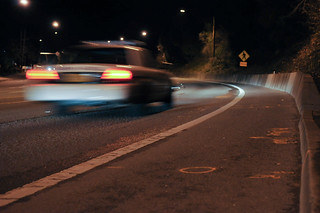
driver doesn’t decide to flee a crash.
(Photo: J.Maus/BikePortland)
Nobody expects to kill a person with their car. This means that the moment you do, your only basis for decision is usually something you heard once from a friend.
And as Portland deals with two major recent hit-and-run cases involving people on bikes, some victim advocates are saying that Oregon needs to do more to spread the idea that it’s morally reprehensible to flee the scene of a collision.
“What’s happened is that Mothers Against Drunk Driving and all these other great organizations have done incredible work over the last 20 years,” Joshua Shulman, a Portland lawyer who works on civil injury cases and has researched the topic, said Friday. “And I’m so glad that they have, because drinking and driving is awful. But one of the side effects of harsh penalties is to make people more likely to avoid them.”
“Drinking and driving is awful. But one of the side effects of harsh penalties is to make people more likely to avoid them.”
— civil injury lawyer Joshua Shulman
In many hit-and-run cases, Shulman said, that’s exactly what happens: a person driving drunk hits someone, panics, heads home and only turns themselves in after sobering up.
“If you leave the scene, it’s shockingly easy to get away with avoiding the DUI,” he said. “The person must have been drinking. People just don’t do this sort of thing if they’re not drunk. But what are you supposed to do? You ask them ‘Were you drinking?’ They say no. Are you supposed to take their photo to every bar in Portland?”
Oregon’s criminal code actually makes few distinctions between leaving the scene of a fatal crash and criminally negligent homicide or second-degree manslaughter, the two likeliest charges for fatal DUIIs. All three are Class B felonies.
But due in part to the successful effort by MADD and others to stigmatize drunken driving, Shulman said judges and juries are more likely to be lenient, unless there’s a DUII conviction (which by law can’t be plea-bargained away).
The result: a perverse incentive, despite the criminal code, for one Oregonian to leave another one bleeding on the street.
“There is a focus on drunk driving, there is now a focus on texting and phoning and all of that, but there’s never been a focus on hit-and-run,” said Kristi Finney of Vancouver, who has devoted much of her life to street safety advocacy after her son Dustin was killed in a hit-and-run on Division Street in 2011. “Some people sympathize with people who hit and run.”
Finney’s case shows another perverse incentive for Oregonians to hit and run: to avoid conviction altogether. Although the man who pled guilty to killing her son only evaded arrest for a few minutes, that window was enough for law enforcement to conclude that they couldn’t be certain of conviction, leading to a plea deal that reduced the driver’s minimum prison sentence.
Hit-and-runs accounted for about one in 20 Oregon injury collisions in 2010 and 2011, according to statistics requested from the state by Shulman’s law office.
Finney, who has worked with Shulman to launch a new website about hit-and-run victims, has tried to mobilize other victims’ families for a MADD-like movement, with little success.
“My thought is that my little voice does practically nothing, and if we can just get a bunch of us together to be a huge voice,” Finney said. “But I just simply cannot get a response from other families. … Some people want to get over it. I don’t want to get over it. I want to get out there and prevent it.”
“It’s almost worse for families of hit and runs than drunk drivers,” said Maureen Inouye, client relations manager for Shulman’s law firm. “There’s not closure.”

(Image from KATU video)
Shulman supports making Oregon’s criminal penalties for hit-and-run clearly higher than for DUII, so people will know that you’re always better off staying at the scene.
But he said legal changes — like one passed this year, which upped the civil penalty for an injury hit-and-run from a one-year license suspension to a three-year suspension — won’t be enough on their own.
“Hardening the law would help, but also the whole concept of what it means to drive a car needs to change,” Shulman said. “We think of it as just getting to work, like it’s nothing. We need to realize that it’s a huge responsibility. … Leaving just should be completely unthinkable.”
Changing the way people think, though, can be the hardest task of all.
“With drinking and driving, one of the things that happens is people drink so often — there’s just millions and millions of people making a decision about that issue very day,” Shulman said. “Whereas with hit and run, people are only in that position if they hit someone. It’s something that most people will never face in their entire lives, and most people [who do] will only do it once. What MADD was able to do was put drunk driving on people’s minds every time they have a drink. I don’t know how to do that with hit-and-run.”
——
Further reading: Why people flee the scene of hit and runs (published here on January 26th, 2012)
— A note from the publisher: This story is part of a new effort here at BikePortland to bring you more, in-depth and original reporting on important issues here on the Front Page. Stay tuned for more stories like this in the weeks to come. — Jonathan

